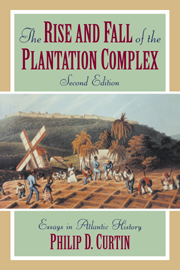8 - Slave societies on the periphery
Published online by Cambridge University Press: 05 June 2012
Summary
The Atlantic slave trade was central to the plantation complex, but it delivered labor for other pruposes as well. In the Americas generally, the death of the Indians meant that all economic development needed imported labor – whether in the true-colony sector of North America or the true-empire sector of the highlands from Mexico south to Chile. The influx of slave labor was so great that it was not until the 1840s that more Europeans than Africans crossed the Atlantic to populate the New World.
Differential population growth
New World populations of European descent were nevertheless comparatively large, and those from Africa were comparatively small. The difference came from differential rates of population growth. As we have seen, people from Africa survived better than people from Europe did in the tropical lowlands, but elsewhere in the Americas, populations from Europe thrived. In general, these settler populations in the New World tended to increase even more rapidly than the population of Europe itself.
The usual explanation is that the standard of living was higher for the settlers than it was for those who stayed at home, which was no doubt the case; but the evidence of historical epidemiology in the nineteenth century suggests that biological factors may also have been present. In the worldwide spread of disease, the Americas, Australasia, and some of the Pacific islands were comparatively isolated. Their people lacked the immunities of the greater intercommunicating zone, and hence died of disease on contact with outsiders.
- Type
- Chapter
- Information
- The Rise and Fall of the Plantation ComplexEssays in Atlantic History, pp. 98 - 110Publisher: Cambridge University PressPrint publication year: 1998

